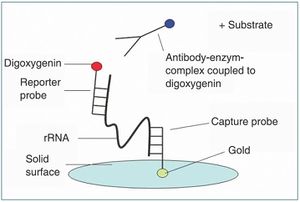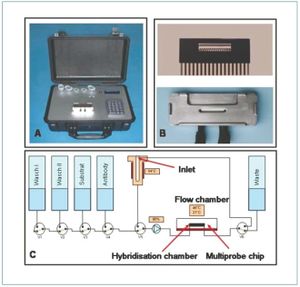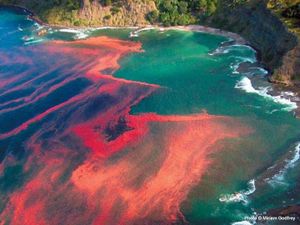ALGADEC - Detection of toxic algae with a semi-automated nucleic acid biosensor
Contents
Introduction
Microalgae are the major producers of biomass and organic compounds in the aquatic environment. Among the marine microalgae there are 97 toxic species (mainly dinoflagellates) known to have the potential to form "Harmful Algal Blooms", the so called HABs (Fig. 1). In recent decades, the public health and economic impacts of toxic algae species appear to have increased in frequency, intensity and geographic distribution (Zingone and Enevoldsen, 2000[1], Daranas et al., 2001[2], Hallegraeff, 2003[3], Moestrup, 2004.[4]). In order to minimise the damage to human health or living resources, such as shellfish and fish, as well as economic losses to fishermen, aquaculture and the tourist industry, efficient monitoring methods are required for monitoring potentially toxic algal species (identification and quantification) (Andersen et al., 2003.[5]).
Methods and techniques

In order to detect toxic algae in the field, a portable semi-automated nucleic acid biosensor was developed in the ALGADEC project [6]. This device enables the electrochemical detection of microalgae from water samples in less than two hours, without the need of expensive equipment. The detection of the toxic algae is carried out on a sensor chip and is based on the so-called sandwich hybridisation technique (Fig. 2). The ALGADEC detection device is semi-automatic. The main steps are executed automatically but filtering and a lysis procedure (digestion of the filtered material) has to be done by hand. The core of the biosensor is a multiprobe chip (Fig. 3) that can be used for the simultaneous detection of 14 different toxic algae plus two controls. Thus, it can be used to detect the species composition in harmful algal blooms.
Sandwich hybridisation
A sandwich hybridisation is a molecular probe-based method for rapid target identification that uses two molecular probes targeting ribosomal RNA (rRNA). A capture probe bound to a solid surface immobilises the target ribosomal RNA and forms a hybrid complex with a second signal probe. An antibody-enzyme complex binds to the signal moiety of the signal probe and reacts with a substrate forming an electrochemical current on the biosensor (Metfies et al., 2005.[7]).
Molecular Probes
Molecular probes are short oligonucleotides (18-25 bases) that are complementary to specific sequences in the genomes of the target organism. Ribosomal RNA genes are widely used targets for the development of molecular probes. They appear in high numbers in target cells and have both conservative and highly variable regions, which make it possible to develop probes that are specific at different taxonomic levels (Groben et al., 2004.[8]).
Implementation
The goal of ALGADEC was the automatic detection of the different toxic algae species in three different areas in Europe: Skagerrak in Norway, the Galician coast in Spain and the area of the Orkney Islands in Scotland. Thus, chip sets for different toxic algae have been developed and tested in the lab for specificity with cultures of known toxic and non-toxic varieties of the same species (Diercks et al., 2008.[9]). The applicability of the ALGADEC biosensor for the detection of toxic algae in the hands of lay persons was evalutated in a workshop with end users of the device. After an introduction of the end users to the handling manual, contaminated field samples from the Orkney Islands (UK) were successfully screened by the end users for the presence of cells from the genus Pseudonitzschia. Chip sets for the following toxic algae are currently available:
- Dinophysis sp.
- Pseudonitzschia sp.
- Lingolodinium polyedrum
- Chrysochromulina polylepis
Prospects
In the course of the ALGADEC-project it was possible to develop a semi-automatic nucleic acid biosensor for the detection of toxic algae. The functionality of the device, even in the hands of lay persons, was shown with laboratory algae cultures, field samples spiked with algae cultures and field samples with naturally occurring toxic algae. However, in the future, the system has to be calibrated and optimised in respect to sensitivity for the detection of the target organisms. The sensitivity of the device is a crucial issue and has to be adapted, to the reference values for toxic algae e.g. toxic Alexandrium sp. in sea water of around ~100 – 250 cells/liter. The original idea of the ALGADEC project was to develop a nucleic acid biosensor for the detection of toxic algae. But the technology suggests an adaptation e.g. to the monitoring of microalgae in general. Therefore, molecular probes will be developed for key species of the phytoplankton of the North Sea. Furthermore, we are currently working on the automation of all steps involved in the analysis of water samples. In the long term a fully automated nucleic acid biosensor will be available that could work on its own or be implemented to the FerryBox-System in order to monitor microalgae autonomously at species level.
See also
Internal Links
- Harmful algal bloom
- Real-time algae monitoring
- Eutrophication in coastal environments
- Ships of opportunity and ferries as instrument carriers
- Differentiation of major algal groups by optical absorption signatures
References
- ↑ Zingone, A. & Enevoldsen, H.O. (2000). The diversity of harmful algal blooms: a challenge for science and management. Ocean & coastal management, 43, 725-748.
- ↑ Daranas A. H., Norte M. and Fernandez, J. J. (2001). Toxic marine microalgae, Toxicon, 39, 1101-1132.
- ↑ Hallegraeff G. M. (2003). Harmful algal blooms: a global overview. In G.M. Hallegraeff, D.M. Anderson & A.D. Cembella (Eds.), Manual on Harmful Marine Microalgae (pp. 25-49). United Nations Educational, Scientific and Cultural Organization.
- ↑ Moestrup, O. (2004). IOC Taxonomic Reference list of Toxic Algae. In O. Moestrup (Ed.), IOC taxonomic reference list of toxic algae. Intergovernmental Oceanographic Commission of the UNESCO.
- ↑ Andersen P., Enevoldsen H. and Anderson, D.M. (2003). Harmful algal monitoring programme and action plan design. In G.M. Hallegraeff, D.M. Anderson & A.D. Cembella (Eds.), Manual on Harmful Marine Microalgae (pp. 627-647). United Nations Educational, Scientific and Cultural Organization.
- ↑ Metfies, K., Diercks, S., Schroder, F., Petersen W. and Hanken, T. 2009. Automated nucleic biosensors - a key to high resolution monitoring of marine phytoplankton, OCEANS 2009-EUROPE, Bremen, 2009, pp. 1-7, doi: 10.1109/OCEANSE.2009.5278312
- ↑ Metfies, K., Huljic, S., Lange, M., & Medlin, L.K (2005). Electrochemical detection of the toxic dinoflagellate Alexandrium ostenfeldii with a DNA-biosensor. Biosens. Bioelectron, 20, 1349-1357.
- ↑ Groben, R., John, U., Eller, G., Lange M. & Medlin L.K. (2004). Using fluorescently-labelled rRNA probes for hierarchical estimation of phytoplankton diversity – a mini-review, Nova Hedwigia, 79, 313-320.
- ↑ Diercks, S., Metfies, K. and Medlin, L.K (2008). Molecular probes for the detection of toxic algae for use in sandwich hybridization formats. Journal of Plankton Research 30(4):439-448
Please note that others may also have edited the contents of this article.
|
Please note that others may also have edited the contents of this article.
|
Please note that others may also have edited the contents of this article.
|
